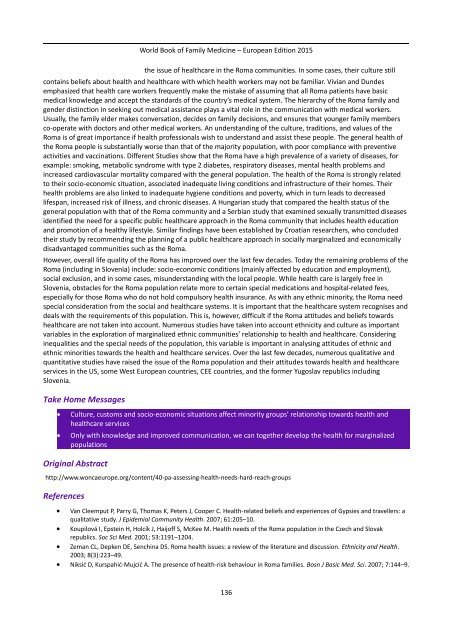Family Medicine
World Book 2015
World Book 2015
Create successful ePaper yourself
Turn your PDF publications into a flip-book with our unique Google optimized e-Paper software.
World Book of <strong>Family</strong> <strong>Medicine</strong> – European Edition 2015<br />
the issue of healthcare in the Roma communities. In some cases, their culture still<br />
contains beliefs about health and healthcare with which health workers may not be familiar. Vivian and Dundes<br />
emphasized that health care workers frequently make the mistake of assuming that all Roma patients have basic<br />
medical knowledge and accept the standards of the country’s medical system. The hierarchy of the Roma family and<br />
gender distinction in seeking out medical assistance plays a vital role in the communication with medical workers.<br />
Usually, the family elder makes conversation, decides on family decisions, and ensures that younger family members<br />
co-operate with doctors and other medical workers. An understanding of the culture, traditions, and values of the<br />
Roma is of great importance if health professionals wish to understand and assist these people. The general health of<br />
the Roma people is substantially worse than that of the majority population, with poor compliance with preventive<br />
activities and vaccinations. Different Studies show that the Roma have a high prevalence of a variety of diseases, for<br />
example: smoking, metabolic syndrome with type 2 diabetes, respiratory diseases, mental health problems and<br />
increased cardiovascular mortality compared with the general population. The health of the Roma is strongly related<br />
to their socio-economic situation, associated inadequate living conditions and infrastructure of their homes. Their<br />
health problems are also linked to inadequate hygiene conditions and poverty, which in turn leads to decreased<br />
lifespan, increased risk of illness, and chronic diseases. A Hungarian study that compared the health status of the<br />
general population with that of the Roma community and a Serbian study that examined sexually transmitted diseases<br />
identified the need for a specific public healthcare approach in the Roma community that includes health education<br />
and promotion of a healthy lifestyle. Similar findings have been established by Croatian researchers, who concluded<br />
their study by recommending the planning of a public healthcare approach in socially marginalized and economically<br />
disadvantaged communities such as the Roma.<br />
However, overall life quality of the Roma has improved over the last few decades. Today the remaining problems of the<br />
Roma (including in Slovenia) include: socio-economic conditions (mainly affected by education and employment),<br />
social exclusion, and in some cases, misunderstanding with the local people. While health care is largely free in<br />
Slovenia, obstacles for the Roma population relate more to certain special medications and hospital-related fees,<br />
especially for those Roma who do not hold compulsory health insurance. As with any ethnic minority, the Roma need<br />
special consideration from the social and healthcare systems. It is important that the healthcare system recognises and<br />
deals with the requirements of this population. This is, however, difficult if the Roma attitudes and beliefs towards<br />
healthcare are not taken into account. Numerous studies have taken into account ethnicity and culture as important<br />
variables in the exploration of marginalized ethnic communities’ relationship to health and healthcare. Considering<br />
inequalities and the special needs of the population, this variable is important in analysing attitudes of ethnic and<br />
ethnic minorities towards the health and healthcare services. Over the last few decades, numerous qualitative and<br />
quantitative studies have raised the issue of the Roma population and their attitudes towards health and healthcare<br />
services in the US, some West European countries, CEE countries, and the former Yugoslav republics including<br />
Slovenia.<br />
Take Home Messages<br />
<br />
<br />
Culture, customs and socio-economic situations affect minority groups' relationship towards health and<br />
healthcare services<br />
Only with knowledge and improved communication, we can together develop the health for marginalized<br />
populations<br />
Original Abstract<br />
http://www.woncaeurope.org/content/40-pa-assessing-health-needs-hard-reach-groups<br />
References<br />
Van Cleemput P, Parry G, Thomas K, Peters J, Cooper C. Health-related beliefs and experiences of Gypsies and travellers: a<br />
qualitative study. J Epidemiol Community Health. 2007; 61:205–10.<br />
Koupilová I, Epstein H, Holcík J, Haijoff S, McKee M. Health needs of the Roma population in the Czech and Slovak<br />
republics. Soc Sci Med. 2001; 53:1191–1204.<br />
Zeman CL, Depken DE, Senchina DS. Roma health issues: a review of the literature and discussion. Ethnicity and Health.<br />
2003; 8(3):223–49.<br />
Niksić D, Kurspahić-Mujcić A. The presence of health-risk behaviour in Roma families. Bosn J Basic Med. Sci. 2007; 7:144–9.<br />
136


